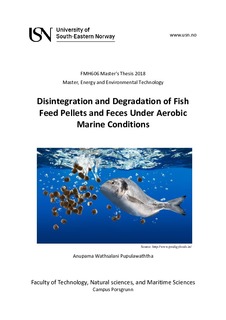| dc.description.abstract | Fish farming industry is a major food industry which cover significant parts of the nutritional requirement of the world’s population. Due to nutritional enrichment by uneaten pellets and fish feces, negative environmental impacts such as eutrophication, saprobiation and hypoxia condition in benthic zone occur in semi-enclosed fjord system.
As the main aim of this study the degree and kinetics aerobic degradation of four sizes of fish pellets (P 1000, P 500, P 200, P 80) and fish waste were determined using static (OxiTop) and dynamic (Micro-Oxymax) respirometry. Chemical analysis of fish pellet solution and fish waste before and after BOD tests were carried out to determine the nutrition release after aerobic degradation. Sinking velocity of fish pellet, dissolution of nutrient and disaggregation rate of pellets were determined to check the influence from these processes for the aerobic degradation.
The TN:TP ratios after BOD test of 28 days and 12 days for pellets is about 3:1 and 3:2 respectively. This suggest the ratio of nutrient supply to marine system after fully and partially aerobic degradation of fish feed. The 50% of final oxygen consumption (t1/2) for P 1000 and P 500 is about 12 days while its 6 days for P 200 and P 80. The degree of aerobic degradation varies as P 200> P 1000, P 500, about 75%-80% and for P 80, about 70%. This is varying with the physical condition of the pellet as whole, grinded, and autoclaved. The degradation kinetics depend on the initial size of pellet, P 200>P 80>P 500>P 1000 demonstrated by the size dependent pseudo first order degradation coefficient (0.09 d-1>0.08 d-1>0.0003 d-1>0.0001 d-1) and kinetics vary with physical condition of pellet as pellet grinded autoclaved>pellet grinded> whole pellet for P 200 due to stimulate hydrolysis of complex compounds in pellet with heat, increase substrate surface area and dissolution of pellets. k1 value for fish waste is about 0.19 d-1 at partially biodegradation stage after half completion of the BOD test. Settling velocity of the pellets where found to be 0.11, 0.10, 0.08 for P 1000, P 200, and P 500, respectively. P 1000 and P 500 pellet disaggregate more during sinking and normally take more time to fully dissolution due to fat layer formation. Analyzing all results from each pellet type using above experiments P 200 (higher kinetics, higher degree of aerobic biodegradation, less amount of organic matter content and dissolution without fat layer formation) make less contribution to negative environmental effect than bigger pellets like P 1000, P 500 (lower k1 value, higher disaggregation, less dissolution) in marine fjord water system. | nb_NO |
